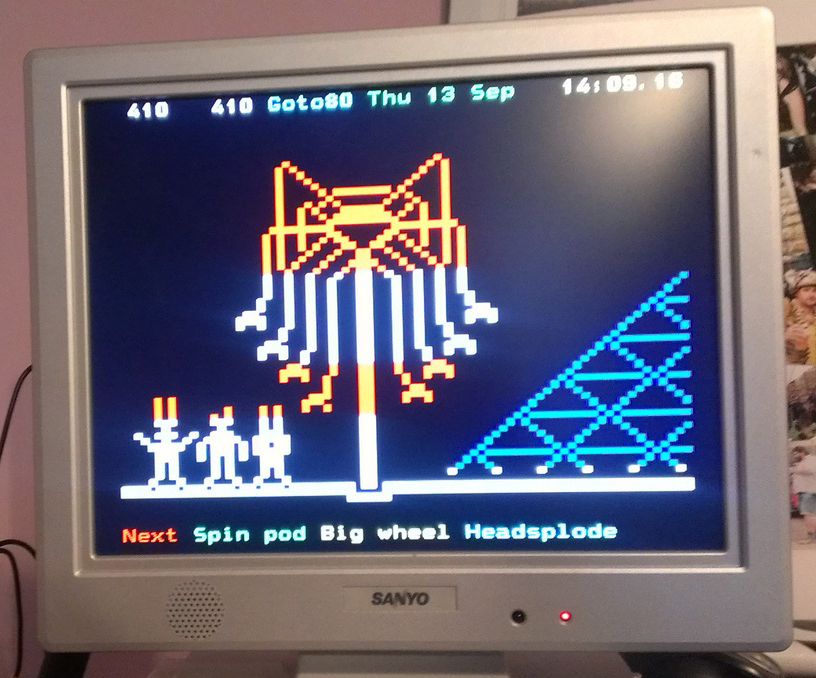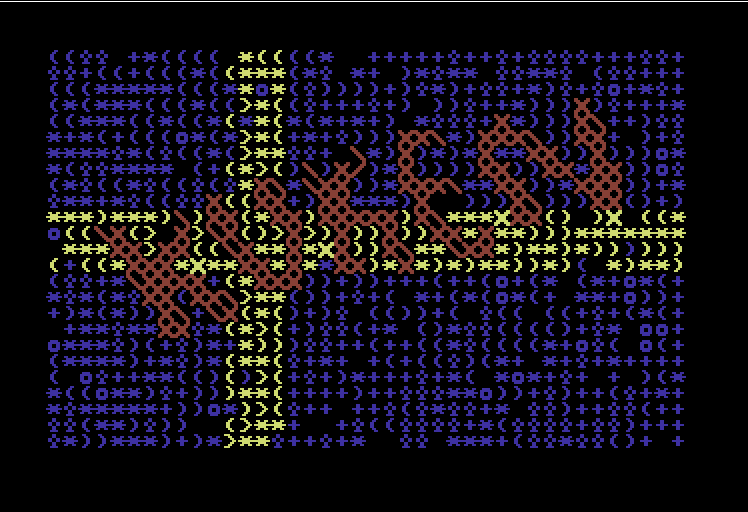
Me and A. Bill Miller wrote a paper on ASCII art and presented it at CAC3 last year. Now we’ve put it online at chipflip.org/06 so check it out!
(logo by Spot/Up Rough)
(enjoy)

Me and A. Bill Miller wrote a paper on ASCII art and presented it at CAC3 last year. Now we’ve put it online at chipflip.org/06 so check it out!
(logo by Spot/Up Rough)
(enjoy)
This is my talk about 8-bit users at Merz Akademie in Stuttgart. I try to explain why it’s so often framed in nostalgia or appropriation, and why we should talk about it in a different way to stay up-to-date with state of the art philosophy!
I wrote more about the talk at Chipflip, and if you want more background you can read my MA thesis on chipmusic. If you dare!
The talk was part of a series called Do You Believe In Users, organized by Olia Lialina. Check more videos of e.g Jason Scott at Merz Akademie’s Vimeo.
The Acid Burger has finally arrived in Australia! It’s a mini-DVD with music and video, placed inside a real hamburger. With cheese.
Since we’ve had troubles with shipping to oz before, we sent the mini-DVD without the actual burger this time. And it worked!
It arrived safely with Ilkke, who found his own burger to put the DVD in. And made this little animation. Fanx! Click to get a better view.
We should all try to find our own burger in life.
So yeah, I quit Facebook. Just like I quit Myspace in 2007. I also quit the Swedish copyright collection society STIM this year. Just prepairing for the future…
I had music in three new C64-games, a movie, a short film, the best bear demo in the world, and some other demoscene thingies. Among them a music competition entry, which randomly played one of two songs (one good and one bad).
I wrote an academic paper on ASCII art together with A Bill Miller. Got my own teletext channel. Showed some art stuff. Trolled around a bit.
We performed The Ferret Show (video) together with Uwe Schenk and his band. The MP3-release was listed as one of the best of 2012. Other MP3-releases were my Devo remix, Curt Lazers’ neo-dansband, some lo-fi pop, ambient, acid, etc. Also made some secret releases only given to 1 person. First a minidisc sent to someone in Helsingborg, then a tomato-USB for someone in Malmö.
I wrote fewer posts for Chipflip, but put out two great releases instead: ??? and Omri Suleiman. More good stuff coming in 2013!
We started a Tumblr, posting a piece of text graphic everyday. It’s the only “curated” archive of text graphics that I know of.
Text graphics is sooo 2012/2013! Me and Raquel Meyers did the first ever 100% PETSCII performance. We used four C64s and did everything in text-mode. Because pixels are for losers!
Next year will start with a performance at Transmediale, using fax and teletext and C64 and so on. Should be good!
While there are still many reasons to use Facebook, the list shrinks every day. The question is not IF you are going to quit Facebook, but WHEN. So why not today? Here are some practical reasons why I’m quitting.
* It’s not for free. It never was. We used to pay with personal information that they used for “improved” advertising. But now we also need to pay with actual money to reach our contacts. If you don’t pay, you won’t even reach half of your followers. Some people have claimed as few as 15%.
* If someone subscribes to you, there’s a big risk that they won’t see your posts. Either because of some mysterious Facebook selection, or because you don’t pay, or because people can’t bother to sift through the spam, or because people just don’t care anymore.
* You can’t trust the statistics. What does it mean that there are 1 billion accounts on Facebook? Who knows what it means to have “1999 followers” or that “1543 people saw this” or “37 people talk about this”. Or if you are an advertiser – how can you know that actual people (and not bots) have clicked your ad? Well, you can’t. You just have to take Facebook’s word for it. And why would you do a thing like that?
* You can’t rely on Facebook. They introduce features that can have huge consequences to people and organizations – without even a warning. And if there is a reason to shut down your content, because of algorithms or complaints or legal battles – they will do it. And you can’t complain to customer service, because you are probably not a customer.
* Facebook will disappear fast after its peak. Unlike other companies that try to control both platform and distribution (Apple, Google, Amazon, etc), Facebook relies too much on its users. The main reason for people to use it, is “my friends use it”. When they start to leave it, Facebook will disappear as fast as it arrived. Time to prepare!
(Instead of Facebook I will be here. Tonight there will be a live streamed gig to celebrate, starting at 19.00 CET)
Today A. Bill Miller is at CAC3 in Paris to present a paper we wrote together. It’s called The Future Potentials of ASCII Art. Dunno if you have to pay to read it or sth, lol, but here is the abstract:
ASCII art is a text-based expression that traditionally is concerned with remediating images, words and objects. The paper describes its historical connections to poetry, programming, literature and hacking and defines ASCII art as a genre, consisting of several categories.
The authors identify a number of movements towards novel forms of ASCII art that explore medium specific characteristics for drawing, design, advertising and conceptual art. The authors also argue that the popularity of digital media, which for example leads to scarcity in URLs, increases the potential for ASCII art to play a more active role in human communication.

Yeah, this could obviously be faked. But don’t worry – you will see soon enough that it’s not. Me and Raquel Meyers are now able to produce our own teletext signal. So now we don’t need a video mixer anymore!
We’ve started to mix teletext with trackers and PETSCII graphics. Check out the first tests at Flickr. There’s also some teletext printouts there, using a TV with a built-in dot matrix printer. Check out text-mode.tumblr.com if you’re hungry for more text graphics.
The newest release at CHIPFLIP has some really good music by Omri Suleiman, and graphics made by me and Raquel Meyers. Let’s stop making boring MP3/JPG-releases and bring back the future of music disks!
Check it out now! (free download, stream, etc)
Ne7 made a logo for me in his latest Amiga ASCII colly. Yeah! Greetz to the elitez!

In Sweden, we celebrate the national day med kuken. This is a PETSCII-remix of a painting that the Swedish police confiscated in 1967. Read more over at the unimitable text-mode.tumblr.com.